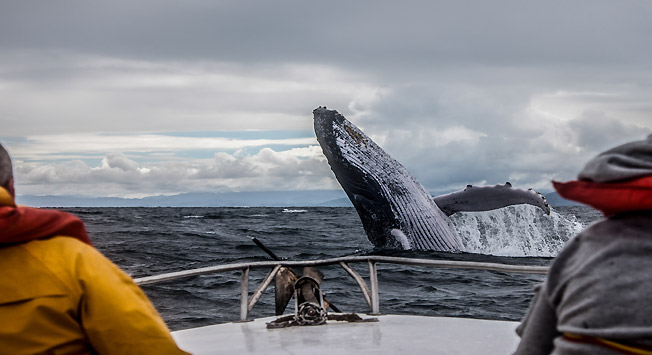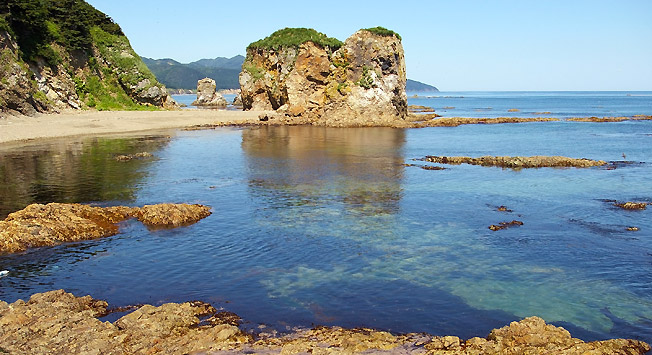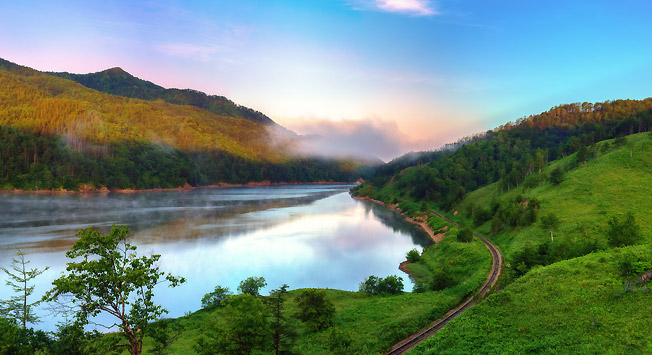
Sakhalin is geographically closer to Tokyo, Beijing and Hong Kong than it is to Moscow, but unlike its Asian neighbors, Russia’s largest island is still blessed with almost unspoiled nature. Infamous for frequent snowstorms in winter that lead to airport closures for days on end, the island offers its fair share of warm sunny days in the summer months.
Marine life
Photo credit: Lori/Legion-Media
Summer is the feeding season for the endangered western gray whales, a species that is believed to be 30 million years old. The whales, which grow to a length of almost 15 meters and weigh around 40 tons, can be spotted from the eastern coast of the island. August is the best month to catch a glimpse of them, as this is when they migrate to the waters near Sakhalin to feed on shrimp and small fish.
The eastern coast of Sakhalin is a short drive from Yuzhno-Sakhalinsk, the island’s capital. The best people to guide a visitor on where to spot the whales are the staff of environmental NGOs operating on the island.
Environmentalists believe that there are only 100 western gray whales near the Asian Pacific coast. These majestic mammals return to the eastern Pacific Ocean in the winter months for breeding.
Other marine mammals are easier to spot. Just east of the southern tip of Sakhalin is a unique and small island that is a nursery for seals. Tyuleny (seal) Island is just 1.6 kilometers long and 19 meters wide, and hosts a large population of seals and birds. The seal rookery is one of the most fascinating natural sites anywhere in Russia. The northern fur seals that live near the island can also be spotted off the east coast of Sakhalin and are among the most sociable species of marine life. They often approach fishing boats.
A variety of sea birds here take up the spaces left vacant by the seals. In the summer one can spot the common murre, kittiwake, crested auklets, Siberian rubythroats, red-necked stints and narcissus flycatchers, among other species. Tour operators in Yuzhno-Sakhalinsk offer day trips to the island.
Warm lakes
Photo credit: Shutterstock/Legion-Media
There are 16,000 lakes spread across the 948-kilometer long island. Only the lakes and lagoons in the southern part of Sakhalin are warm enough for swimming.
Tunnaicha Lake, about 30 kilometers away from Yuzhno-Sakhalinsk, is surrounded by mountains and is one of many tranquil spots near the capital. Parallel to Tunnaciha and separated by a narrow stretch of land from the Sea of Okhotsk is Izmenchivoe Lake. Locals believe the land around the lake contains minerals and often take soil back with them to use as fertilizers at their dachas.
Southern Sakhalin has several lakes and lagoons that are popular with fishermen including Busse, a lagoon known for its scallops. Busse is a one-hour drive from the world’s largest gas-liquefying plant. In summer, the series of lakes in southern Sakhalin known as Teplie ozera (warm lakes) are a great place for camping and swimming.
If you’re interested in Soviet history, then visit one of the largest marine collective farms in the former Soviet Union. The Kirov collective farm near the town of Korsakov was established in May 1959 and is still in operation. The Kirov, which was formed by 15 fishing cooperatives, is one of the few collective farms that survived the demise of the USSR. You can buy salmon, pollock, cod, flounder and herring here.
Sakhalin is famous for its seafood and the local cuisine reflects this richness. Many shops sell salads with shrimp, squid and crab and it is easy to find oysters, scallops, crabs and other types of fish in the markets.
Water sports
Aniva bay, Sakhalin. Photo credit: RIA Novosti/Vladimir Fedorenko
The warm lakes are a popular spot on weekends for windsurfers. The weather can be unpredictable at times, but the best months are August and September. Busse is popular for kayaking and canoeing. Fishermen in diving suits row to the center of the lake in canoes to catch scallops.
There have been complaints recently that water-skiers are destroying the peace and quiet of some of the larger lakes, a consequence of the immense wealth that was created locally after the oil and gas boom.
For diving head to the southernmost end of the island. In August and September the waters of Aniva Bay, north of the Japanese island of Hokkaido, are warm enough for swimming. The more daring visitors swim from Sakhalin to Aniva Cape lighthouse, which was built by Japan in 1939. Swimmers are advised to exercise caution, since there have been occasional great white shark sightings in the bay.
The warm weather in Sakhalin stretches on later than in most parts of Russia, making it an ideal place to enjoy summer into the early fall.
How to get there
Flight
There are three daily flights from Yuzhno-Sakhalinsk to Moscow and several to Khabarovsk and Vladivostok. Many Sakhalin residents use Vladivostok as a hub to travel to Asian and other Russian cities. There are direct flights from Yuzhno-Sakhalinsk to cities in Korea, Japan and China.
Ferry
From May to October, there is a daily ferry service from Wakanai in Japan's Hokkaido Prefecture to Korsakov in Sakhalin. A daily ferry service from Kholmsk in southwestern Sakhalin to Vanino in Khabarovsk Territory runs throughout the year. Travelers can connect to the Baikal-Amur Line and the Trans Siberian Railway in Vanino.
All rights reserved by Rossiyskaya Gazeta.
Subscribe
to our newsletter!
Get the week's best stories straight to your inbox